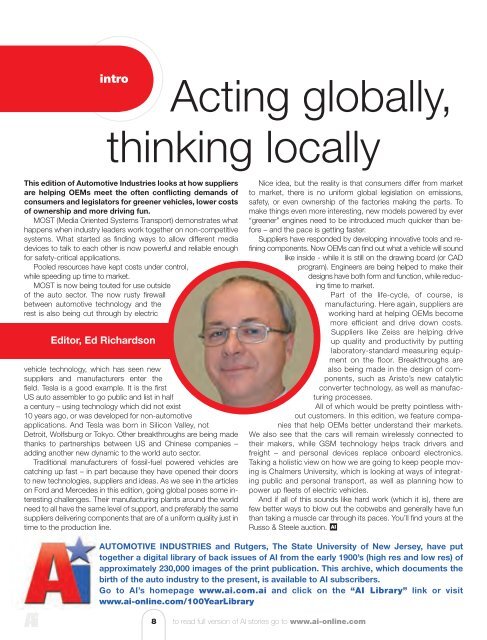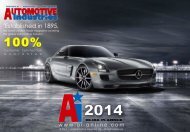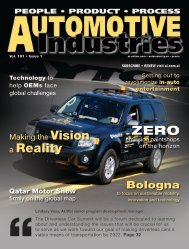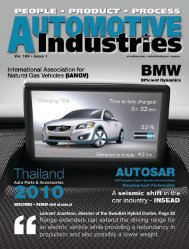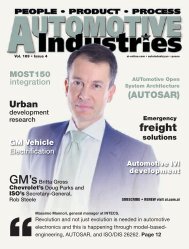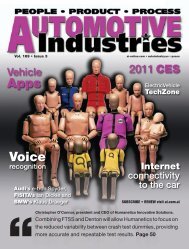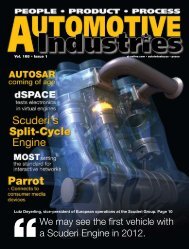Q2 2010 - Automotive Industries
Q2 2010 - Automotive Industries
Q2 2010 - Automotive Industries
You also want an ePaper? Increase the reach of your titles
YUMPU automatically turns print PDFs into web optimized ePapers that Google loves.
intro<br />
This edition of <strong>Automotive</strong> <strong>Industries</strong> looks at how suppliers<br />
are helping OEMs meet the often conflicting demands of<br />
consumers and legislators for greener vehicles, lower costs<br />
of ownership and more driving fun.<br />
MOST (Media Oriented Systems Transport) demonstrates what<br />
happens when industry leaders work together on non-competitive<br />
systems. What started as finding ways to allow different media<br />
devices to talk to each other is now powerful and reliable enough<br />
for safety-critical applications.<br />
Pooled resources have kept costs under control,<br />
while speeding up time to market.<br />
MOST is now being touted for use outside<br />
of the auto sector. The now rusty firewall<br />
between automotive technology and the<br />
rest is also being cut through by electric<br />
Editor, Ed Richardson<br />
Acting globally,<br />
thinking locally<br />
vehicle technology, which has seen new<br />
suppliers and manufacturers enter the<br />
field. Tesla is a good example. It is the first<br />
US auto assembler to go public and list in half<br />
a century – using technology which did not exist<br />
10 years ago, or was developed for non-automotive<br />
applications. And Tesla was born in Silicon Valley, not<br />
Detroit, Wolfsburg or Tokyo. Other breakthroughs are being made<br />
thanks to partnerships between US and Chinese companies –<br />
adding another new dynamic to the world auto sector.<br />
Traditional manufacturers of fossil-fuel powered vehicles are<br />
catching up fast – in part because they have opened their doors<br />
to new technologies, suppliers and ideas. As we see in the articles<br />
on Ford and Mercedes in this edition, going global poses some interesting<br />
challenges. Their manufacturing plants around the world<br />
need to all have the same level of support, and preferably the same<br />
suppliers delivering components that are of a uniform quality just in<br />
time to the production line.<br />
Nice idea, but the reality is that consumers differ from market<br />
to market, there is no uniform global legislation on emissions,<br />
safety, or even ownership of the factories making the parts. To<br />
make things even more interesting, new models powered by ever<br />
“greener” engines need to be introduced much quicker than before<br />
– and the pace is getting faster.<br />
Suppliers have responded by developing innovative tools and refining<br />
components. Now OEMs can find out what a vehicle will sound<br />
like inside - while it is still on the drawing board (or CAD<br />
program). Engineers are being helped to make their<br />
designs have both form and function, while reducing<br />
time to market.<br />
Part of the life-cycle, of course, is<br />
manufacturing. Here again, suppliers are<br />
working hard at helping OEMs become<br />
more efficient and drive down costs.<br />
Suppliers like Zeiss are helping drive<br />
up quality and productivity by putting<br />
laboratory-standard measuring equipment<br />
on the floor. Breakthroughs are<br />
also being made in the design of components,<br />
such as Aristo’s new catalytic<br />
converter technology, as well as manufacturing<br />
processes.<br />
All of which would be pretty pointless without<br />
customers. In this edition, we feature companies<br />
that help OEMs better understand their markets.<br />
We also see that the cars will remain wirelessly connected to<br />
their makers, while GSM technology helps track drivers and<br />
freight – and personal devices replace onboard electronics.<br />
Taking a holistic view on how we are going to keep people moving<br />
is Chalmers University, which is looking at ways of integrating<br />
public and personal transport, as well as planning how to<br />
power up fleets of electric vehicles.<br />
And if all of this sounds like hard work (which it is), there are<br />
few better ways to blow out the cobwebs and generally have fun<br />
than taking a muscle car through its paces. You’ll find yours at the<br />
Russo & Steele auction. AI<br />
AUTOMOTIVE INDUSTRIES and Rutgers, The State University of New Jersey, have put<br />
together a digital library of back issues of AI from the early 1900’s (high res and low res) of<br />
approximately 230,000 images of the print publication. This archive, which documents the<br />
birth of the auto industry to the present, is available to AI subscribers.<br />
Go to AI’s homepage www.ai.com.ai and click on the “AI Library” link or visit<br />
www.ai-online.com/100YearLibrary<br />
8 to read full version of AI stories go to www.ai-online.com


